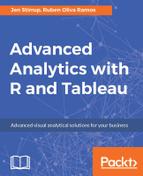R gives you good diagnostic information to help you take the next step in your analysis, which is to visualize the results.
Statistics provides us with a method of investigation where other methods haven't been able to help, and their success or failure isn't clear to many people. If we see a correlation and think that the relationship is obvious, then we need to think again. Correlation can help people to insinuate causation. It's often said that correlation is not causation, but what does this mean? Correlation is a measure of how closely related two things are. We can use other statistical methods, such as structural equation modeling, to help us to identify the direction of the relationship, if it exists, using correlated data. It's a complex field in itself, and it isn't covered in this book; the main point here is to show that this is a complex question.
How does correlation help us here? For our purposes, the most interesting statistic is the coefficient of determination, denoted R2 and pronounced R-squared, which indicates how well data points fit a statistical model –sometimes simply a line or curve. R-squared measures how close the data is to the fitted regression line. It is also known as the coefficient of multiple determination for multiple regression.
It can be explained by R-squared = Explained variation/Total variation, and it is always explained as a percentage between 0 and 100%: Generally speaking, the higher the R-squared value, then the better the model fits the data. In our example, our model fit is found to be 69%, which is reasonably successful. We would need to map out the data to visualize it better, and to see if the model fits a linear line or not.
Regression problems in business are trying to predict a continuous variable, such as the price of a car, or the amount of profit. In this example, we have created a model that can be used to predict sales. As a next step, we could try to pick apart the model to understand what variables are contributing to the success of the model, and which ones are not contributing.
